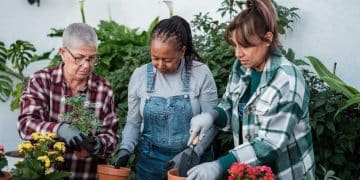The Power of Collaboration: Boost Your Community Project Reach

The Power of Collaboration: How Partnering with Local Businesses Can Double the Reach of Your Community Action Project involves strategically aligning community initiatives with businesses to expand impact and resources.
Community action projects are vital for addressing local needs and fostering positive change. However, these projects often face challenges in reaching a wider audience and securing adequate resources. What if there was a way to amplify your project’s impact, engage more community members, and gain access to valuable resources? Discover the power of collaboration: How partnering with local businesses can double the reach of your community action project, and transform your vision into a reality.
Partnering with local businesses is not just about securing funding; it’s about creating a mutually beneficial relationship that enhances community engagement, boosts brand visibility, and drives sustainable impact. Learn how strategic collaborations can unlock new opportunities and transform your project.
Unlocking the Power of Collaboration for Community Projects
In the realm of community development, the power of collaboration: How partnering with local businesses can double the reach of your community action project is often underestimated. Strategic alliances can inject much-needed resources, expertise, and community support into initiatives aimed at improving local areas.
Let’s delve deeper into why these collaborations are so crucial and how to make them work effectively.
The Mutual Benefits of Collaboration
When community action projects partner with local businesses, both parties stand to gain significantly. Businesses can enhance their public image and demonstrate corporate social responsibility, while projects gain access to resources and support they might otherwise lack.
- Enhanced Visibility: Partnerships increase the visibility of both the project and the business within the community.
- Resource Sharing: Businesses can provide funding, equipment, or expertise, while projects offer volunteer opportunities and community engagement.
- Community Goodwill: Collaborations foster a sense of goodwill and strengthen the ties between businesses and the community they serve.

These benefits illustrate why seeking partnerships should be a priority for any community action project seeking to maximize its impact.
Identifying Potential Business Partners
Identifying the right business partners is a critical first step in leveraging the power of collaboration: How partnering with local businesses can double the reach of your community action project. Not all businesses will be a good fit, so it’s essential to strategically target those that align with your project’s mission and values.
Consider businesses that have a vested interest in the community and a track record of supporting local initiatives.
Researching Local Businesses
Before reaching out to potential partners, conduct thorough research to understand their business goals, values, and community involvement. This will help you tailor your pitch and demonstrate how a partnership can benefit them.
- Online Presence: Start by exploring their website and social media channels to gauge their brand image and community engagement.
- Local Events: Attend local business events to network and learn more about potential partners.
- Community Reputation: Talk to community members to understand which businesses are known for their support of local initiatives.
By doing your homework, you can identify businesses that are not only financially stable but also genuinely interested in making a positive impact on the community.
Crafting a Compelling Partnership Proposal
Once you’ve identified potential partners, the next step is to create a compelling partnership proposal that clearly outlines the benefits of collaboration. Your proposal should be tailored to each business, highlighting how the partnership will help them achieve their goals while supporting your project.
Clearly state the project goals, the resources you need, and the specific ways in which the business can contribute.
Elements of an Effective Proposal
A well-structured proposal should include a brief overview of your project, a detailed description of the partnership benefits, and a clear outline of the partnership terms.
- Project Overview: Provide a concise summary of your project’s mission, goals, and impact.
- Partnership Benefits: Highlight how the partnership will benefit the business, such as increased visibility, enhanced brand image, and employee engagement opportunities.
- Partnership Terms: Clearly outline the roles and responsibilities of each party, the duration of the partnership, and the metrics for success.

By presenting a clear and compelling proposal, you can increase your chances of securing valuable partnerships that will help your project thrive.
Sustaining Long-Term Partnerships
Securing a partnership is just the beginning. To truly harness the power of collaboration: How partnering with local businesses can double the reach of your community action project, you need to cultivate and sustain long-term relationships built on trust and mutual benefit. Regular communication, shared goals, and public recognition are essential for maintaining strong partnerships.
Foster a collaborative environment that encourages open dialogue and shared decision-making.
Maintaining Strong Relationships
Effective communication is crucial for sustaining long-term partnerships. Keep your business partners informed about your project’s progress, celebrate successes together, and address any challenges promptly.
- নিয়মিত Updates: Provide regular updates on your project’s progress, including milestones achieved and challenges faced.
- Public Recognition: Acknowledge your partners’ contributions publicly through social media, newsletters, and community events.
- Feedback Loops: Seek feedback from your partners on how the partnership can be improved and address their concerns promptly.
By prioritizing communication and nurturing relationships, you can transform short-term collaborations into lasting partnerships that benefit both your project and the community.
Measuring and Communicating the Impact
To demonstrate the value of your partnerships, it’s essential to measure and communicate the impact of your project. Collecting data on key metrics, such as the number of people served, the amount of resources generated, and the positive changes achieved, will help you showcase the tangible benefits of the power of collaboration: How partnering with local businesses can double the reach of your community action project.
Highlight the successes and share the data with your partners and the community.
Data Collection and Reporting
Implement a system for collecting data on key metrics and regularly report on your project’s impact. This will help you demonstrate the value of your partnerships and attract additional support.
- Define Metrics: Identify the key metrics that reflect your project’s success, such as the number of volunteers engaged, the amount of funding raised, and the number of people served.
- Collect Data: Implement a system for collecting data on these metrics, using surveys, interviews, and direct observation.
- Report regularly: Prepare regular reports on your project’s impact and share them with your partners and the community.
By measuring and communicating the impact of your project, you can reinforce the value of your partnerships and attract additional resources and support.
| Key Point | Brief Description |
|---|---|
| 🤝 Mutual Benefits | Partnerships benefit both community projects and local businesses through resource sharing and enhanced visibility. |
| 🔍 Identifying Partners | Research local businesses to find those aligned with your project’s mission and values for potential collaboration. |
| 📝 Compelling Proposals | Craft proposals that highlight mutual benefits and clearly outline partnership details for potential business collaborators. |
| 📊 Measuring Impact | Tracking and communicating the project’s impact with data reinforces the collaborative value, attracting more resources and support. |
Frequently Asked Questions
Local businesses can benefit by enhancing their public image, demonstrating corporate social responsibility, and gaining increased visibility within the community through the power of collaboration: How partnering with local businesses can double the reach of your community action project.
A community action project should look for businesses that align with their mission and values, have a vested interest in the community, and have a track record of supporting local initiatives. Financial stability is also crucial.
A compelling proposal should include a project overview, a detailed description of the partnership benefits for both parties, and a clear outline of the roles, responsibilities, duration, and metrics for success. It should highlight the power of collaboration: How partnering with local businesses can double the reach of your community action project.
Sustaining long-term partnerships requires regular communication, shared goals, public recognition of the business’s contributions, and a collaborative environment that encourages open dialogue and shared decision-making.
Measuring and communicating the project’s impact demonstrates the value of the partnerships, reinforces the businesses’ investment, attracts additional support, and showcases the tangible benefits that come from the power of collaboration: How partnering with local businesses can double the reach of your community action project.
Conclusion
The power of collaboration: How partnering with local businesses can double the reach of your community action project is undeniable. By strategically aligning with local businesses, community projects can unlock new resources, expand their reach, and create lasting positive change.
Embrace the opportunity to build strong, mutually beneficial partnerships that will elevate your community action project and drive sustainable impact. Together, we can create stronger, more vibrant communities.





